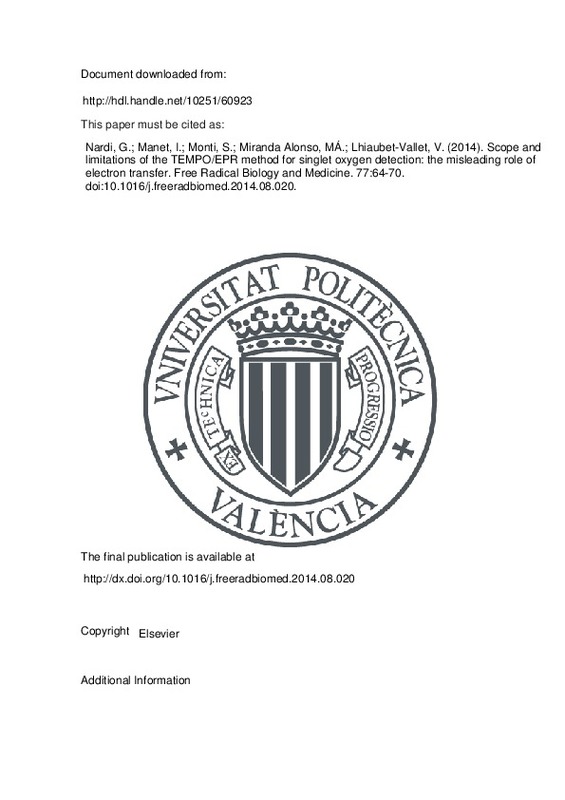Nardi, G.; Manet, I.; Monti, S.; Miranda Alonso, MÁ.; Lhiaubet-Vallet, V. (2014). Scope and limitations of the TEMPO/EPR method for singlet oxygen detection: the misleading role of electron transfer. Free Radical Biology and Medicine. 77:64-70. https://doi.org/10.1016/j.freeradbiomed.2014.08.020
Por favor, use este identificador para citar o enlazar este ítem: http://hdl.handle.net/10251/60923
|
Título:
|
Scope and limitations of the TEMPO/EPR method for singlet oxygen detection: the misleading role of electron transfer
|
|
Autor:
|
Nardi, Giacomo
Manet, Ilse
Monti, Sandra
 Miranda Alonso, Miguel Ángel
Lhiaubet-Vallet, Virginie
Miranda Alonso, Miguel Ángel
Lhiaubet-Vallet, Virginie
|
|
Entidad UPV:
|
Universitat Politècnica de València. Instituto Universitario Mixto de Tecnología Química - Institut Universitari Mixt de Tecnologia Química
Universitat Politècnica de València. Departamento de Química - Departament de Química
|
|
Fecha difusión:
|
|
|
Resumen:
|
For many biological and biomedical studies, it is essential to detect the production of O-1(2) and quantify its production yield. Among the available methods, detection of the characteristic 1270-nm phosphorescence of ...[+]
For many biological and biomedical studies, it is essential to detect the production of O-1(2) and quantify its production yield. Among the available methods, detection of the characteristic 1270-nm phosphorescence of singlet oxygen by time-resolved near-infrared (TRNIR) emission constitutes the most direct and unambiguous approach. An alternative indirect method is electron paramagnetic resonance (EPR) in combination with a singlet oxygen probe. This is based on the detection of the TEMPO free radical formed after oxidation of TEMP (2,2,6,6-tetramethylpiperidine) by singlet oxygen. Although the TEMPO/EPR method has been widely employed, it can produce misleading data. This is demonstrated by the present study, in which the quantum yields of singlet oxygen formation obtained by TRNIR emission and by the TEMPO/EPR method are compared for a set of well-known photosensitizers. The results reveal that the TEMPO/EPR method leads to significant overestimation of singlet oxygen yield when the singlet or triplet excited state of the photosensitizer is efficiently quenched by TEMP, acting as electron donor. In such case, generation of the TEMP+(center dot) radical cation, followed by deprotonation and reaction with molecular oxygen, gives rise to an EPR-detectable TEMPO signal that is not associated with singlet oxygen production. This knowledge is essential for an appropriate and error-free application of the TEMPO/EPR method in chemical, biological, and medical studies.
[-]
|
|
Palabras clave:
|
EPR
,
Photosensitizer
,
Singlet oxygen
,
TEMPO
,
Time-resolved near-infrared emission
,
Free radicals
|
|
Derechos de uso:
|
Reserva de todos los derechos
|
|
Fuente:
|
Free Radical Biology and Medicine. (issn:
0891-5849
) (eissn:
1873-4596
)
|
|
DOI:
|
10.1016/j.freeradbiomed.2014.08.020
|
|
Editorial:
|
Elsevier
|
|
Versión del editor:
|
http://dx.doi.org/10.1016/j.freeradbiomed.2014.08.020
|
|
Código del Proyecto:
|
info:eu-repo/grantAgreement/MINECO//CTQ2012-32621/ES/FOTOQUIMICA DE LA FORMACION Y REPARACION DE LESIONES BIPIRIMIDINICAS DE TIPO (6-4), DEWAR Y ESPORA/ /
...[+]
info:eu-repo/grantAgreement/MINECO//CTQ2012-32621/ES/FOTOQUIMICA DE LA FORMACION Y REPARACION DE LESIONES BIPIRIMIDINICAS DE TIPO (6-4), DEWAR Y ESPORA/ /
info:eu-repo/grantAgreement/MINECO//RD12%2F0013%2F0009/
info:eu-repo/grantAgreement/GVA//PROMETEOII%2F2013%2F005/ES/ESPECIES FOTOACTIVAS Y SU INTERACCION CON BIOMOLECULAS/
info:eu-repo/grantAgreement/MICINN//FI09%2F00312/ES/FI09%2F00312/
info:eu-repo/grantAgreement/MEC//RYC-2007-00476/ES/RYC-2007-00476/
info:eu-repo/grantAgreement/MINECO//SEV-2012-0267/ES/SEV-2012-0267/
[-]
|
|
Agradecimientos:
|
The Spanish government (CTQ2012-32621, RyC-2007-00476, PFIS FI09/00312, Severo Ochoa Program SEV-2012-0267), the Carlos III Institute of Health (Grant RIRAAF, RETICS Program RD12/0013/0009), and the Generalitat Valenciana ...[+]
The Spanish government (CTQ2012-32621, RyC-2007-00476, PFIS FI09/00312, Severo Ochoa Program SEV-2012-0267), the Carlos III Institute of Health (Grant RIRAAF, RETICS Program RD12/0013/0009), and the Generalitat Valenciana (Prometeo II/2013/005) are gratefully acknowledged for financial support. Dr. A. Vidal-Moya is acknowledged for his help with the EPR measurements.
[-]
|
|
Tipo:
|
Artículo
|







![[Cerrado]](/themes/UPV/images/candado.png)


